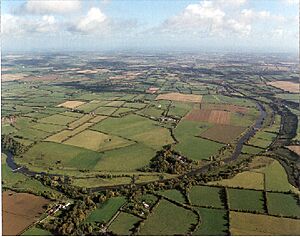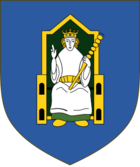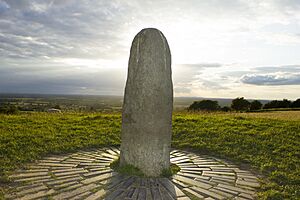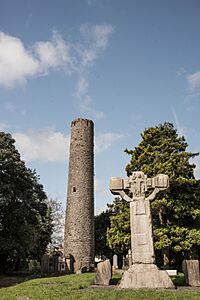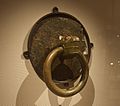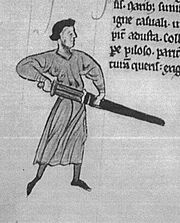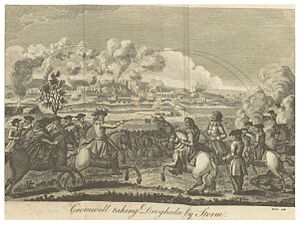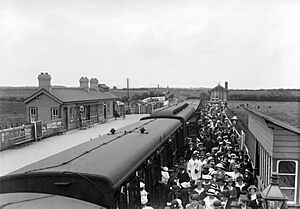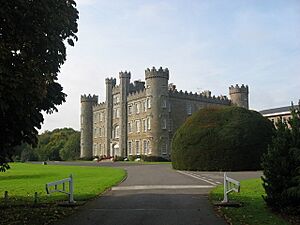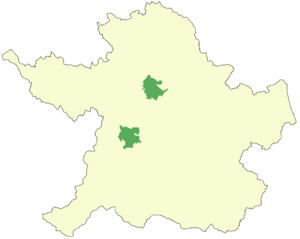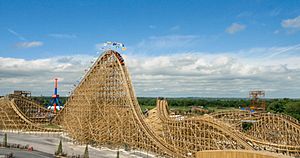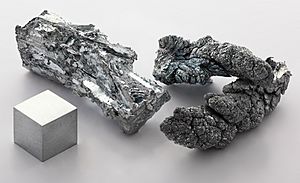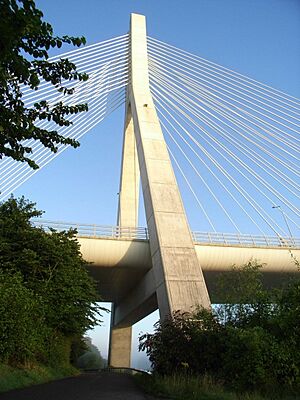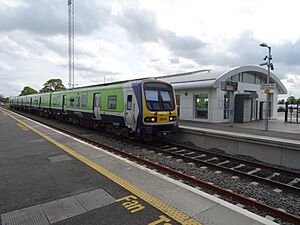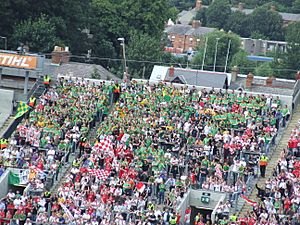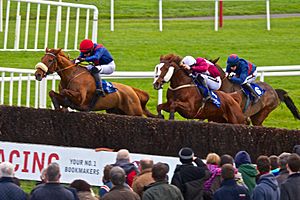County Meath facts for kids
Quick facts for kids
County Meath
Contae na Mí
|
||
|---|---|---|
|
||
| Nickname(s):
The Royal County
|
||
| Motto(s):
Irish: Tré Neart le Chéile
"Stronger Together" |
||
| Anthem: "Beautiful Meath" (unofficial) | ||
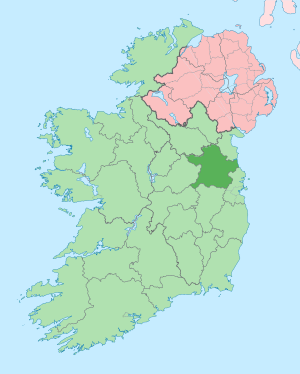 |
||
| Country | Ireland | |
| Province | Leinster | |
| Region | Eastern and Midland | |
| History | Date | |
| Kingdom of Meath | Antiquity | |
| Lordship of Meath | 1172 | |
| Shired | 1297 | |
| Division of Meath | 1542 | |
| County town | Navan (1898–) Trim (1297–1898) |
|
| Area | ||
| • Total | 2,342 km2 (904 sq mi) | |
| Area rank | 14th | |
| Highest elevation | 276 m (906 ft) | |
| Population
(2022)
|
||
| • Total | 220,826 | |
| • Rank | 8th | |
| • Density | 94.289/km2 (244.21/sq mi) | |
| Vehicle index mark code |
MH | |
County Meath (pronounced MEEDH) is a county in the Republic of Ireland. It is part of the Leinster province. Meath is surrounded by seven other counties. These include County Dublin to the southeast and County Louth to the northeast. It also has a short coastline along the Irish Sea. Meath County Council is the local government for the county.
Meath is the 14th largest county in Ireland by land area. It is the 8th most populated, with over 220,000 people in 2022. The main town and largest settlement is Navan. Other important towns are Trim, Kells, and Ashbourne.
People often call Meath "The Royal County". This is because the historic Kingdom of Meath was once home to the High King of Ireland. This was a very important leader long ago. The county has many amazing historical sites. These include the Hill of Tara, Newgrange, and Trim Castle. The famous Battle of the Boyne was also fought here in 1690. Meath is also special because it has Gaeltacht areas. These are places where the Irish language is still spoken every day.
Contents
- Exploring Meath's Geography
- A Look at Meath's History
- Places to Visit in Meath
- People and Population in Meath
- Meath's Economy
- Getting Around Meath
- Sports in Meath
- Famous People from Meath
- See also
Exploring Meath's Geography
Meath is the 14th largest county in Ireland. It is the second largest in Leinster. It borders seven other counties. Meath has a short coastline of about 20 kilometers along the Irish Sea. This coastline is between the River Boyne and Delvin River. Navan, the county town, is in the middle of Meath. It is about 50 km from Dublin.
Meath's Natural Features

Meath has a mostly flat and green landscape. This is because of the fertile land along the Boyne valley. This land is great for farming. Even though it's mostly rural, many people live here. Meath is one of the most densely populated counties in Ireland.
The River Boyne is the most important river in Meath. It is 112 km long. The Boyne has shaped the county's history for thousands of years. Two main rivers flow into the Boyne: the Leinster Blackwater and the Enfield Blackwater. In the east, the River Nanny and the Delvin River flow into the Irish Sea.
Meath used to have many forests. But most were cut down between the 16th and 18th centuries. Now, only about 5.7% of the county is covered by forests. This is much lower than the national average for Ireland.
Meath's Climate
Meath has a mild, wet climate. It has cool winters and mild, humid summers. Temperatures are usually not extreme. The weather station at Dunsany records the climate data. The average high temperature in January is about 7.3°C. In July, it's about 19.6°C. May and June are usually the sunniest months. October is the wettest month, and June is the driest. Snow is rare and usually light. Frost is common in central and western areas.
How Meath's Landscape Was Formed
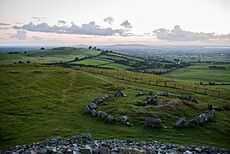
Most of Meath's land is made of limestone. This rock formed a very long time ago. The county's landscape was also shaped by the Last Glacial Period, which ended about 11,700 years ago. Glaciers left behind a mix of clay, sand, and gravel.
Meath is mostly flat. Most of the county is less than 100 meters above sea level. The highest point is Slieve na Calliagh, which is only 276 meters high. This makes it one of the lowest "county tops" in Ireland. The Hill of Tara is also a prominent feature. It is 155 meters high and offers great views.
Historic Areas: Baronies and Townlands
There are eighteen historic areas in Meath called baronies. These are old divisions of land. They are still officially recognized. The largest barony is Kells Upper, and the smallest is Dunboyne.
- Deece Upper
- Deece Lower
- Duleek Upper
- Duleek Lower
- Dunboyne
- Fore
- Kells Upper
- Kells Lower
- Lune
- Morgallion
- Moyfenrath Upper
- Moyfenrath Lower
- Navan Upper
- Navan Lower
- Ratoath
- Skreen/Skryne
- Slane Upper
- Slane Lower
Townlands are the smallest official land divisions in Ireland. Meath has about 1,634 townlands. They vary in size.
Towns and Villages in Meath
Navan is the county town and the largest settlement. It is also the 4th largest town in Ireland (not counting cities). Meath has many towns and villages. In recent years, towns closer to Dublin, like Ashbourne and Dunboyne, have grown a lot.
|
Largest cities or towns in Meath (Census 2022)
Source: |
||
|---|---|---|
| Rank | Pop. | |
| 1 | Navan | 33,886 |
| 2 | Ashbourne | 15,680 |
| 3 | Laytown–Bettystown–Mornington–Donacarney | 15,642 |
| 4 | Ratoath | 10,077 |
| 5 | Trim | 9,563 |
| 6 | Dunboyne | 7,155 |
| 7 | Dunshaughlin | 6,644 |
| 8 | Kells | 6,608 |
| 9 | Drogheda (Southern Environs) | 5,000 |
| 10 | Duleek | 4,899 |
A Look at Meath's History
Meath is known as "The Royal County" because it was once the center of power for the High King of Ireland. The ancient Kingdom of Mide (Meath) was very important. The Hill of Tara was the main seat of the High King. The amazing Brú na Bóinne site, with tombs like Newgrange, is 5,000 years old. It is a UNESCO World Heritage Site.
Ancient Times in Meath

People have lived in Meath for a very long time. The oldest signs of humans are flints found near Navan, dating back 9,500 BC. This shows that hunter-gatherers lived here.
Later, during the Neolithic period, farming began. People had more time and resources. They built huge stone monuments for the dead. The most famous are Newgrange, Knowth, and Dowth at Brú na Bóinne. These tombs are older than Stonehenge and the Egyptian pyramids. Newgrange is famous for how sunlight shines into its chamber during the winter equinox. This shows that early settlers knew a lot about astronomy.
Around 500 BC, the Celts arrived in Ireland. They brought much of what we know as Gaelic Irish culture. This included the Irish language and myths. The Boyne Valley monuments became part of Celtic stories. For example, the hero Cú Chulainn was said to be born at Newgrange.
Early Christian Period (400–1169 AD)
The Kingdom of Meath
The early history of Meath is a mix of facts and myths. The Hill of Tara became a center of power around 400 AD. The Uí Néill family established a kingdom in Meath. They became known as the Kings of Tara. Over time, they united smaller kingdoms to form the Kingdom of Mide, which means "middle."
The title of "High King of Ireland" became more important over time. Máel Sechnaill mac Máele Ruanaid, a King of Mide, was one of the first to be called "High King." Later, Brian Boru challenged the Uí Néill's power. He eventually became High King himself, ending the Uí Néill's long rule over the title.
Monasteries and Vikings
Saint Patrick is said to have brought Christianity to Ireland, with many stories centered in Meath. By the 6th century, Christianity was widespread. Monasteries became important centers of learning. Irish scholars copied valuable Latin texts. They also sent missionaries to Europe. This period is known as the "Golden Age of Irish Christianity."
Meath's monasteries, like Kells and Clonard Abbey, were very important. They created famous artworks, such as the Book of Kells.
-
Tara Brooch,
c. 7th century -
Book of Kells,
c. 9th century
However, the wealth of these monasteries attracted Vikings. Vikings raided Ireland in the 8th century. Irish monasteries built round towers to protect themselves. Vikings later settled in coastal areas, founding cities like Dublin.
Norman Arrival and English Rule (1169–1542)
The Normans in Meath
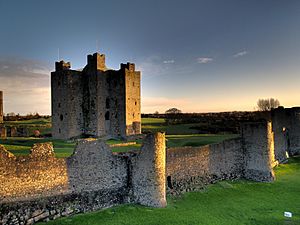
In 1169, Diarmait Mac Murchada returned to Ireland with Norman allies. This began the Norman Invasion of Ireland. The Normans quickly conquered many areas. Henry II of England came to Ireland in 1171 to take control. He gave the Kingdom of Meath to Hugh de Lacy. De Lacy had to conquer it himself.
De Lacy invaded Meath and built many castles, like Trim Castle. Trim became his main stronghold. By 1175, de Lacy had conquered all of Meath. He expanded towns like Trim, Athboy, Kells, and Navan.
Over the next centuries, English power in Ireland weakened. The Black Death also affected towns. Many Norman families became more like the Irish. By the 1500s, only a small area around Dublin, called The Pale, was fully controlled by the English. Part of Meath was inside The Pale, and part was outside.
Kingdom of Ireland (1542–1800)
Changes Under the Tudors
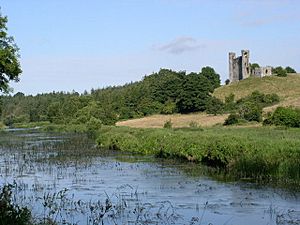
In 1542, Henry VIII of England declared himself King of Ireland. This was because he had broken away from the Catholic Church. The English also took over church lands in Meath. Monasteries were closed.
In 1543, Meath was officially divided into two counties: Meath and Westmeath. This was to help the English government control the areas better. After a major war in 1603, England passed Penal Laws. These laws restricted the rights of Catholics.
Protestant Rule and Major Battles
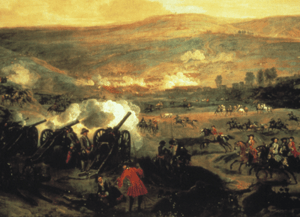
In 1641, a rebellion began in Ulster. This was because Irish people had lost their lands. Meath was affected by this conflict. The Catholic leaders of Meath joined the rebellion. They formed a government called Confederate Ireland. They fought against the English Parliament.
However, Oliver Cromwell defeated them. He led a very harsh conquest of Ireland. Many people died. More Penal Laws were put in place. Catholics lost more land and rights.
Later, James II of England was supported by Irish Catholics. But he was defeated by William of Orange at the Battle of the Boyne in July 1690. This battle was fought near Oldbridge in Meath. It was a very important event in Irish history. It ended the hope of an independent Irish kingdom for a long time.
Towards the end of the 1700s, some Penal Laws were eased. Ireland gained some independence for a short time. But in 1800, Ireland became part of the United Kingdom.
The 19th Century in Meath

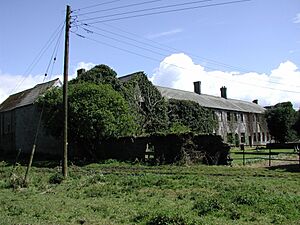
After the Napoleonic Wars ended in 1815, Ireland's economy struggled. Farmers in Meath faced hard times. This led to a rise in Irish nationalism. Many people wanted to end the union with Britain.
Daniel O'Connell held a huge rally on the Hill of Tara in 1843. Between 500,000 and 1 million people attended. This showed how strong nationalist feelings were.
The Great Famine (1845–49) had a terrible impact on Meath. The population dropped from over 183,000 in 1841 to 67,000 by 1900. The Irish language also almost disappeared in the county. The famine led to more demands for land reform.
In 1898, the Local Government Act changed how local areas were run. Meath County Council was created. Navan became the new county town, taking over from Trim.
Meath in the 20th Century
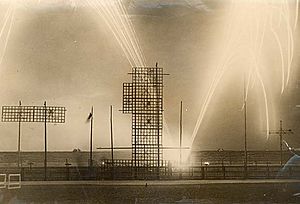
The 1916 Easter Rising was a key event for Irish independence. The Battle of Ashbourne was one of the few fights outside Dublin. Irish Volunteers defeated a police force there.
After Ireland gained independence, efforts were made to revive the Irish language. Five Gaeltacht areas were set up in Meath. The ancient Tailteann Games were also brought back.
Meath's population began to grow again after the 1960s. New jobs and investments came to the county. By 2011, Meath's population was higher than it was before the famine. This makes it one of only five counties to achieve this.
Places to Visit in Meath
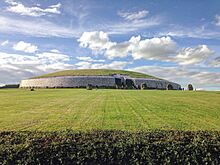
Meath is full of historical sites. You can find landmarks from every period of Irish history.
- Prehistoric tombs: Like those at Brú na Bóinne (Newgrange, Knowth, Dowth).
- Early Christian monasteries: Such as Kells Abbey and Bective Abbey.
- Norman castles: Including Trim Castle and Dunmoe Castle.
- Manor houses: Like Slane Castle.
- Famine memorials: The workhouse and graveyard at Dunshaughlin.
- Modern history sites: The Battle of Ashbourne site from the 1916 Easter Rising.
Meath also has natural beauty. It has scenic lakes, beaches, and wooded areas. Several sites are protected by the National Parks and Wildlife Service. These include the River Nanny Estuary & Shore and the River Boyne & River Blackwater.
Famous Landmarks

- Athcarne Castle
- Athlumney Castle
- Battle of the Boyne Visitor Centre
- Bective Abbey
- Clonard Abbey
- Dangan Castle
- Dowth
- Dunsany Castle and Demesne
- Dunmoe Castle
- Dunshaughlin Famine Workhouse
- Fairyhouse Racecourse
- Fourknocks Passage Tomb
- Gormanston Castle
- Hill of Slane
- Hill of Tara
- Hill of Ward
- Irish Military War Museum
- Kells Abbey
- Killeen Castle
- Knowth
- Loughcrew
- Newgrange
- Oldcastle World War I POW Camp
- Slane Castle
- Spire of Lloyd
- Trim Castle
- Trim Cathedral
Natural Places to See

- Balrath Woods
- Bettystown Beach
- Boyne Valley
- Girley Bog
- Grove Gardens
- Jamestown Bog
- Killyconny Bog
- Larchill Arcadian Gardens
- Loughs of the Upper Boyne Valley
- Lough Sheelin
- Loughcrew Historic Gardens
- Molerick Bog
- Mount Hevey Bog
- Nanny Estuary
- Rathbeggan Lakes
- Slieve na Calliagh
- Sonairte National Ecology Centre
People and Population in Meath
Meath's population was 220,826 in 2022. This was a big increase of over 13% since 2016. Meath is the second fastest growing county in Ireland. Many people have moved to Meath from other parts of Ireland, especially from Dublin. People from other countries have also moved here.
Meath is the least "native" county in Ireland. Only about 32% of residents were born in Meath. Almost half were born elsewhere in Ireland, and about 18% were born abroad. The county is quite densely populated.
In 2022, about 6.4% of the population was under 5 years old. About 23.5% were between 5 and 19. Most people (57.8%) were between 20 and 65. About 12.3% were over 65.
Population Changes Over Time
Meath's population dropped a lot between 1841 and 1901, mainly due to the Great Famine. It then stayed steady until the 1970s. After that, it started growing quickly. This was due to more births and people moving into the county. By 2011, Meath's population was higher than its peak before the famine.
Many people have moved to Meath from other countries, especially from Poland, Romania, and Lithuania. This happened after these countries joined the European Union in 2004.
Different Backgrounds in Meath
In 2022, most people in Meath (89.9%) were White. About 2.6% were Asian, and 1.8% were Black.
Religion in Meath
| Religion in Meath (2022) | ||||
|---|---|---|---|---|
| Roman Catholicism | 72.7% | |||
| No religion | 13.1% | |||
| Other Christian | 7.3% | |||
| Islam | 1.4% | |||
| Hinduism | 0.4% | |||
| Other stated religions | 0.8% | |||
| Not Stated | 4.3% | |||
In 2022, about 82.6% of people in Meath said they had a religion. Most of these (80%) were Christian. The largest group was Roman Catholicism. Other Christian groups included Orthodox Christianity and the Church of Ireland.
Among non-Christian religions, Muslims were the largest group. There were also people who followed Hinduism and Buddhism.
A growing number of people in Meath say they have no religion. This group has increased a lot since 2011.
The Irish Language in Meath
Meath has the only Gaeltacht areas in Leinster. These are Ráth Chairn and Baile Ghib. They are small areas where the Irish language is spoken every day. These Gaeltachts were set up by the government in the 1930s. Families who spoke Irish moved there from other parts of Ireland.
In 2022, about 39.8% of Meath residents could speak Irish. Many schools in Meath also teach through Irish.
Meath's Economy
Meath's economy is strong. In 2017, it ranked 6th among Irish counties for total household income. Major industries include services, retail, farming, mining, and tourism.
Jobs and Businesses
Many people in Meath work in services, retail, and hospitality. Navan used to be known for making carpets, but that industry has changed.
Tourism is important because of Meath's many historical sites. It is called "Ireland's Heritage Capital." Tourists can visit ancient tombs, castles, and manor houses. Meath also has beautiful natural areas. Emerald Park in Ashbourne is Ireland's only permanent amusement park. It has Cú Chulainn, Ireland's largest rollercoaster.
Meath also has a growing science and biotechnology industry. Large pharmaceutical companies have facilities here.
Farming in Meath

Farming is a big part of Meath's economy. The county produces beef, pork, dairy, poultry, vegetables, and cereals. Meath is ranked second in Ireland for vegetable and rapeseed oil production.
In 2018, Meath had the 8th largest cattle herd in Ireland. Most of these were dairy cows. The county also has many sheep and pigs. There are over 4,600 farms in Meath. The average farm size is larger than the national average. Farming brings in over €541 million to the local economy each year.
Mining and Energy
Meath has large amounts of Lead and Zinc underground. These metals are mined at Tara Mine in Navan. Tara is Europe's largest and deepest mine. It has been operating since 1977.
There are also large deposits of gravel, limestone, and shale. These are used for quarrying and cement production. Ireland's first waste-to-energy plant opened in Duleek in 2011. It produces electricity from waste.
Getting Around Meath
Roads
Meath has good road connections. Four motorways pass through the county:
- The M3 connects Navan to Dublin.
- The M4 goes through the south of the county towards Sligo and Galway.
- The M1 (Dublin to Belfast route) crosses East Meath.
- A part of the N2 near Ashbourne was upgraded to the M2 motorway.
Bus Éireann and other companies provide bus services. Dublin Bus also serves areas close to Dublin.
Trains
Irish Rail offers train services from Dunboyne and M3 Parkway to Dublin. Laytown railway station and Gormanston railway station are on the Northern Commuter Line. Enfield is on the Western Commuter Line.
Navan currently has a freight-only train line. There are plans to reopen a direct passenger train line from Dublin to Navan in the future.
Air Travel
For international flights, Meath uses Dublin Airport. It is the closest major airport and has good road links. For smaller planes, there are several airstrips in the county. These are used by local flying clubs.
Sports in Meath
Gaelic Games
Gaelic football is the most popular sport in Meath. The Meath county football team plays in national and provincial competitions. Meath has won the All-Ireland Senior Football Championship 7 times. They have also won 21 Leinster Senior Football Championship titles. Their biggest rival is Dublin.
Within the county, clubs compete in the Meath Senior Football Championship. Navan O'Mahonys is the most successful club.
In Hurling, the Meath county hurling team competes in national leagues and championships. However, Meath is not as strong in hurling as it is in football. Kilmessan and Trim are the most successful hurling clubs in the county.
Horse Sports
Horse racing, horse breeding, and horse training are very popular in Meath. There are many horse studs in the county. Race courses include Navan, Fairyhouse, and Bellewstown. These host different types of horse races. The Irish Grand National has been held at Fairyhouse since 1870. Beach horse racing also takes place at Laytown Racecourse.
The Tattersalls Country House hosts international horse events.
Other Sports
Association football (soccer) is also popular in Meath. Clubs like Parkvilla F.C. and Dunboyne A.F.C. play in leagues. Recently, players from Meath like Darragh Lenihan, Jamie McGrath, and Evan Ferguson have played for the Republic of Ireland national football team.
Golf is widely played. Killeen Castle has a championship golf course designed by Jack Nicklaus. It hosted the 2011 Solheim Cup. Other popular golf courses include Knightsbrook Golf Club and Royal Tara Golf Club.
Athletics is organized by the Meath Athletics Board. They are based at Claremont Stadium in Navan. Sara Treacy from Dunboyne represented Ireland in the 2016 Summer Olympics.
Several Rugby union teams from Meath compete in the Leinster League. These include Ashbourne RFC and Navan R.F.C.. Famous rugby player Shane Horgan is from Bellewstown.
Famous People from Meath
- Pierce Brosnan – Actor, known for playing James Bond.
- Sharon Horgan – Actress, writer, and producer.
- Hector Ó hEochagáin – TV and radio presenter.
- Tommy Tiernan – Comedian and actor.
- Shane Horgan – Former Ireland rugby international.
- Evan Ferguson – Professional footballer.
- Thomas Ashe – Irish Volunteer leader during the 1916 Easter Rising.
- Daniel O'Connell – Famous Irish political leader.
- Charles Stewart Parnell – Important Irish nationalist politician.
See also
 In Spanish: Condado de Meath para niños
In Spanish: Condado de Meath para niños



